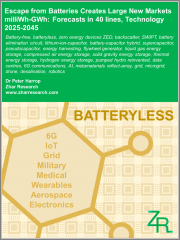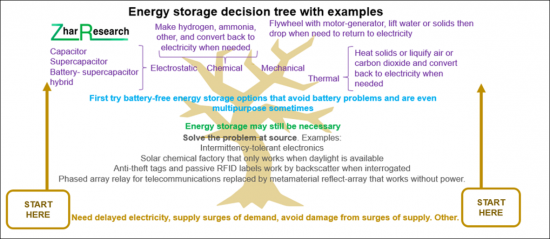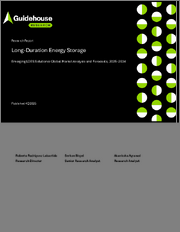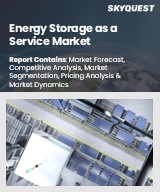
|
시장보고서
상품코드
1590947
전지로부터의 탈각이 대규모 신시장 창출 milliWh-GWh : 40라인의 예측 및 기술(2025-2045년)Escape from Batteries Creates Large New Markets milliWh-GWh: Forecasts in 40 lines, Technology 2025-2045 |
||||||
배터리 불필요 스토리지는 20년 후에는 5배의 2,500억 달러의 사업이 될 것으로 예측되고 있습니다.
펄스 & 고전력 스토리지
슈퍼커패시터, 플라이휠 발전기, 양수 발전 등 기존의 스토리지에도 성장이 보이지만, 성장의 대부분은 많은 새로운 스토리지 형태에 의한 것입니다. 리튬 이온 커패시터는 현재 전자기 무기, 열핵 반응로, 채굴용 차량에 사용되고 있습니다. 탄탈 하이브리드 커패시터는 펄스 레이더와 같은 군용기 용도로 더욱 침투합니다. 또, 리프팅 블록, 지하 양수 발전, 압축 공기나 액체 가스, 히트 펌프식 축열 등을 이용한 대규모 송전망이 현재 구축되고 있습니다. 대부분의 배터리는 GWh를 얻는 데 더 많이 구입하지만 대체품은 모두 스케일 이점이 크고 불연성이며 열화와 누출이 거의 없습니다. 풍력 발전이나 태양광 발전이 1개월에 1회밖에 사용할 수 없다는 새로운 요구에도 대응할 수 있습니다.
거의 또는 전혀 저장하지 않고 관리하는 방법
이 보고서는 또한 태양열 담수화, 무인 항공기 및 계획 중 6G 통신 장치에서 볼 수 있는 스토리지 제거에 대해 다룹니다. Dracula, EnOcean, 8Power 등이 판매하는 에너지 수확을 이용한 배터리 프리 센서, 빌딩 제어, IoT 노드 등의 중간적인 옵션도 있습니다.
캡션 : 에너지 스토리지의 의사결정 트리와 예

본 보고서에서는 전지로부터의 탈각에 의한 신시장 동향을 조사했으며, 전지의 한계와 과제, 전지로부터의 탈각의 동향, 전지 불필요한 시스템의 유형과 개요, 주요 기술의 연구 파이프라인, 기술 로드맵, SWOT 분석, 주요 기업 프로파일 등을 정리했습니다.
목차
제1장 주요 요약 및 총론
제2장 서문
- 개요
- 배터리의 한계
- 리튬 이온 전지의 화재가 계속되고 있는 이유
- 전동화, 전지 채용, 전지 폐지의 메가 트렌드
- 스토리지에 대한 영향(2025-2045년)
- 2025년에 도입되는 전지 및 전지리스의 고정형 스토리지 기술의 비교 및 미래 동향
- 전지 점유율(2025-2045년)
제3장 전지 불필요 시스템 : 백 스캐터(EAS, RFID, 6G SWIPT), 전지 불필요 회로, 자기 급전형 초저전력 회로 및 센서, 수급 관리
- 개요
- 백스캐터 및 SWOT
- 배터리를 최소화하는 회로 설계
- V2G, V2H, V2V에 의한 전지의 배제 및 태양광 패널로부터의 직접 차량 충전
- 수요 관리 : 저장 불필요한 태양광 담수화 장치(2024년)
- 소스 제어 : 진보(2024년)
- 전지의 배제 및 사양
- 배터리가 필요없는 에너지 수확
제4장 정전 스토리지 : 슈퍼커패시터, 슈도 커패시터, 리튬 이온 커패시터 및 기타 BSH
- 커패시터의 위치와 그 변형
- 선택 범위 : 커패시터에서 슈퍼커패시터, 배터리까지
- 연구 파이프라인 : 순수한 슈퍼커패시터
- 연구 파이프라인 : 하이브리드 접근
- 연구 파이프라인 : 슈도 커패시터
- 슈퍼커패시터와 그 파생품의 실제 용도 및 잠재적 용도
- 슈퍼커패시터 기업 103사의 평가 : 10항목
- 리튬 이온 커패시터 및 기타 배터리 슈퍼커패시터 하이브리드 BSH 스토리지
제5장 LGES(액화가스 에너지 저장) : LAES 또는 CO2
- 개요
- LAES(액화 공기 에너지 저장) LDES(장기 에너지 저장 시스템)
- 액화 이산화탄소 LDES
제6장 CAES(압축 공기 에너지 저장)
- 개요
- 공급 부족이 클론을 끌어 당긴다
- CAES 시장의 위치
- CAES와 LAES의 파라미터 평가
- CAES 기술 옵션
- CAES 제조업체, 프로젝트, 연구
- 시스템 설계자 및 공급업체의 CAES 프로파일 및 평가
- ALCAES(스위스)
- APEX CAES(미국)
- Augwind Energy(이스라엘)
- Cheesecake Energy(영국)
- Corre Energy(네덜란드)
- Gaelectric(아일랜드)
- Huaneng Group(중국)
- Hydrostor(캐나다)
- LiGE Pty(남아프리카)
- Storelectric(영국)
- Terrastor Energy Corporation(미국)
- SWOT 평가
제7장 기계식 저장 : APHES(선진 양수 발전)·SGES(고체 중력 에너지 저장)·전기에서 전기로의 플라이휠
- APHES(선진 양수 발전)
- SGES(고체 중력 에너지 저장)
- 전기에서 전기로의 플라이휠
제8장 수소 및 기타 화학 중간체 LDES
- 개요
- 화학 중간체 LDES의 스위트 스폿
- 53개 연구의 진보(2025년, 2024년)
- LDES에 있어서의 메탄 및 암모니아와 수소의 비교
- 수소 LDES 리더 : Calistoga Resiliency Centre USA
- 계산에 의해 장기의 LDES에서는 수소가 승리하는 것이 판명
- 광업 대기업은 신중하게 많은 선택을 진행하고 있습니다
- 건물 및 기타 좁은 위치
- 수소 저장 기술
- LDES의 수소 저장 파라미터 평가
- LDES에서 수소, 메탄, 암모니아 : SWOT 평가
제9장 지연 전력을 위한 ETES(열에너지 저장)
- 개요
- 연구의 진보(2024년)
- 열 엔진 접근은 성공 : Echogen USA
- 극단적인 온도와 광전 변환의 이용
- 하나의 플랜트에서 지연 열과 전력 판매
- LDES용 ETES : SWOT 평가
- ETES의 파라미터 평가
Summary
Battery-free storage will quintuple to become a $250 billion business in 20 years. A new 493-page Zhar Research report has the detail. It is, "Escape from Batteries Creates Large New Markets milliWh-GWh: Forecasts in 40 lines, Technologies 2025-2045".
Pulse and high-power storage
There is growth in the traditional forms - supercapacitors, flywheel generators and pumped hydro. However, most of the growth comes from a host of new forms. Lithium-ion capacitors are now seen in electromagnetic weapons, thermonuclear reactors and mining vehicles. Tantalum hybrid capacitors further penetrate military aircraft applications such as pulsed radar. Massive grid storage is being built based on lifting blocks, underground pumped hydro, compressed air and liquid gas, heat pump thermal storage. With most batteries, to get GWh you just buy more, whereas all alternatives have great economy of scale, they are all non-flammable and they have little or no fade and self-leakage. They better meet the new need of wind and solar power being feeble for a month at a time.
How to manage with little or no storage
The report also covers the elimination of storage as seen in next solar desalination, some drones and some planned 6G Communications devices. Add the in-between option of battery-free sensors, building controls and IOT nodes with energy harvesting sold by Dracula, EnOcean, 8Power and others.
Do not make batteries your first choice
Electronics and electrical designers now first consider if they need batteries - from chip to power station - because the new battery-free options are often far better. This report is their essential reference, assessing hundreds of companies that can now supply and the remarkable new research advances through 2024. It answers questions such as:
- Gaps in the market?
- Emerging competition?
- Full list of technology options?
- 2024 research pipeline analysis?
- Technology sweet spots by parameter?
- Zhar Research appraisals by technology?
- Market forecasts by value and GWh 2025-2045?
- Technology readiness and potential improvement?
- Technology parameters compared against each other?
- Market drivers and forecasts of background parameters?
- Potential winners and losers by company and technology?
- Technologies compared by numbers GW, GWh, delay, duration, etc.?
- Appraisal of proponents, your prospective partners and acquisitions?
- Evolving market needs and technology milestones in roadmaps by year 2025-2045?
Report findings
The Executive Summary and Conclusions (39 pages) is the quick read, with many new infograms and 40 forecast lines with explanation. One image is "Lithium-ion capacitor LIC market positioning by energy density spectrum" showing images of applications over a range of energy density and cycle life. Another shows latest grid and off-grid storage projects - duration vs power - for six battery-free forms compared with battery versions.
Chapter 2. Introduction (7 pages) explains battery limitations, how lithium-ion battery fires are ongoing with many 2024 examples, electrification megatrends, battery adoption, battery elimination. See implications for storage 2025 - 2045: batteries will lose share yet remain the largest value market.
The rest of the report is extremely detailed, starting with a chapter on how to minimise or eliminate storage. Other chapters deep-dive into battery-free storage, - electrostatic, mechanical, thermal, chemical - spanning microWh to GWh, electronics to heavy engineering, pulse to one year of storage. See this formidable virtuosity increasing to replace many batteries and do what batteries can never achieve but realise there is inability impact some other battery applications.
The 63 pages of Chapter 3 concern "Systems that eliminate batteries: backscatter (EAS, RFID, 6G SWIPT), battery elimination circuits, self-powering ultra-low-power circuits and sensors, demand and supply management". Navigate the jargon such as Electronic Article Surveillance EAS , passive RFID, SWIPT, AmBC, CD-ZED for 6G Communications, V2G, V2H, V2V and vehicle charging directly from solar panels. 13 primary energy harvesting technologies are compared. See examples of battery-free desalinators, cameras, drones, IOT nodes and the significance of 25 research advances through 2024.
Chapter 4. "Electrostatic storage: Supercapacitors, pseudocapacitors, lithium-ion capacitors, other BSH" (119 pages) spans activities of 103 companies compared in ten columns, a flood of important research advances in 2024, and a very wide variety of applications emerging. That spans aerospace, electric vehicles: AGV, material handling, car, truck, bus, tram, train, grid, microgrid, peak shaving, renewable energy, uninterrupted power supplies, medical and wearables, data centers, welding, laser cannon, railgun, pulsed linear accelerator weapon, capacitor-supercapacitor hybrids in radar. All have growth ahead but battery-supercapacitor hybrids have the greatest potential 2025-2045.
In electricity generation, your solar house will continue to have a battery. At the other extreme, national and continental grids will suffer massive earthworks and massive delays to get the very lowest levelised cost of storage LCOS up to months. However, there is a very large intermediate requirement emerging from the strong trend to factories, towns and islands being off-grid or capable of being off grid using wind and solar power for around 100MW. They prefer no long delays or major earthworks. Capital cost and long life, low maintenance, small footprint matter here. New redox flow batteries serve well potentially up to one month storage but they have competition from the subject of Chapter 5. "Liquefied gas energy storage LGES: Liquid air LAES or CO2" (22 pages, 5 companies). See SWOT appraisals, parameter comparisons and a niche opportunity in grids as well.
Chapter 6. Compressed air CAES (59 pages) covers the main competitor for pumped hydro grid storage as batteries fail to keep up with ever more wind and solar power demanding ever longer storage duration. Appraise 13 participants, strong research advances and major orders in 2024. Agree with the US Department of Energy that CAES will have one of the lowest LCOS and a splendid lack of expensive or toxic materials?
Chapter 7. "Mechanical storage: Advanced pumped hydro APHES, solid gravity energy storage SGES, flywheels for electricity-to-electricity" (90 pages) delves into a flood of 2024 research, 12 companies, many options. It sees greatest potential in APHES, a large system pumping water into mines being significant in 2024, then SGES for mainstream grid requirements. Flywheels tend to lose out to supercapacitors and their variants for high power density and pulse applications.
Chapter 8. "Hydrogen and other chemical intermediary LDES" (55 pages) reports potentially a very large market extending up to seasonal storage because it could store 10GWh levels underground. However, with only one small minigrid being prepared with tank hydrogen, the scope for extreme arguments for and against is considerable. Of possible chemical intermediaries, only hydrogen has a chance, mostly in salt caverns, but leakage is considerable, causing global warming, and efficiency very poor. Some will be built. Then we shall know the parameters.
Chapter 9. "Thermal energy storage for delayed electricity ETES" reports heating rocks then making steam for turbine generation of electricity has been a failure but 2024 research and the activity of several companies has led to one major installation using heat pumps in thermal storage and there is a wild card of white heat reconverted using photovoltaics. Thermal may be a niche grid/ minigrid storage opportunity.
For those wishing to enjoy this $250 billion opportunity, the essential handbook is Zhar Research report, "Escape from Batteries Creates Large New Markets milliWh-GWh: Forecasts in 40 lines, Technologies 2025-2045".
CAPTION: The energy storage decision tree with examples. Source, Zhar Research report, "Escape from Batteries Creates Large New Markets milliWh-GWh: Forecasts in 40 lines, Technologies 2025-2045".

Table of Contents
1. Executive summary and conclusions
- 1.1. Purpose and scope of this report
- 1.2. Methodology of this analysis
- 1.3. Battery current challenges and why alternatives are being adopted
- 1.3.1. General situation in electronics and electrical engineering
- 1.3.2. Battery challenges for 6G Communications and IoT and action arising 2025-2045
- 1.4. Battery-free options: eliminating storage or using alternative storage 2025-2045
- 1.5. Battery elimination options beyond drop-in replacement by battery-less storage devices
- 1.5.1. Electronics, telecommunication, electrical engineering
- 1.5.2. To the rescue: WPT, WIET, SWIPT evolution to 2045
- 1.5.3. Evolution of wireless electronic devices needing no on-board energy storage 1980-2045
- 1.5.4. SWOT appraisal of circuits and infrastructure that eliminate storage
- 1.6. Why batteries may only dominate the middle ground in 2045
- 1.7. Batteryless storage device toolkit 2025-2045
- 1.7.1. Options by size
- 1.7.2. Example: Lithium-ion capacitor LIC market positioning by energy density spectrum
- 1.7.3. Possible scenario: stationary storage batteries vs alternatives TWh cumulative 2025-2045
- 1.7.4. Example: Installed and committed stationary storage projects 2025 showing many battery and battery-less options competing
- 1.7.5. Long duration energy storage LDES toolkit for grids, microgrids, 6G base stations, data centers 2025-2045
- 1.7.6. SWOT appraisal of battery-less storage devices
- 1.8. System strategies to achieve less or no storage: combine and compromise
- 1.9. Market forecasts 2025-2045 in 40 lines
- 1.9.1. Energy storage device market battery vs batteryless $ billion 2025-2045
- 1.9.2. Possible scenario for leading storage technologies TWh cumulative 2025-2045
- 1.9.3. Supercapacitor EDLC, pseudocapacitor and battery-supercapacitor hybrid BSH $ billion 2025-2045
- 1.9.4. Total LDES value market percent in three size categories 2025-2045 table, graphs
- 1.9.5. Total LDES value market $billion X100 in three size categories 2025-2045
- 1.9.6. Total LDES value market $billionX100 by four regions 2025-2045
- 1.9.7. Regional share of LDES value market percent in four regions 2025-2045.
- 1.9.8. LDES market in 9 technology categories $ billion 2025-2045 table, graphs, explanation
- 1.9.9. LDES total value market showing beyond-grid gaining share 2025-2045
- 1.9.10. Total pumped hydro storage market including LDES $ billion 2023-2045
2. Introduction
- 2.1. Overview
- 2.2. Battery limitations
- 2.3. How lithium-ion battery fires are ongoing
- 2.4. Megatrends of electrification, battery adoption and battery elimination
- 2.5. Implications for storage 2025 - 2045
- 2.6. Duration vs power of many battery and batteryless stationary storage technologies deployed and deploying in 2025 showing future trends
- 2.7. How batteries will lose share 2025-2045
3. Systems that eliminate batteries: backscatter (EAS, RFID, 6G SWIPT), battery elimination circuits, self-powering ultra-low-power circuits and sensors, demand and supply management
- 3.1. Overview
- 3.1.1. Battery elimination options beyond drop-in replacement by battery-less storage devices
- 3.1.2. Strategies to achieve less or no storage
- 3.1.3. Enablers of self-powered, battery-free devices that can be combined
- 3.2. Backscatter with SWOT
- 3.2.1. Electronic Article Surveillance EAS , passive RFID and beyond
- 3.2.2. SWIPT AmBC and CD-ZED for 6G Communications and IOT
- 3.2.3. SWOT and 34 other advances in 2024, 2023
- 3.3. Circuit design to minimise batteries
- 3.3.1. Battery elimination circuits BEC in drones and electric cars
- 3.3.2. Intermittency tolerant electronics: BFree
- 3.4. Battery elimination by V2G, V2H, V2V and vehicle charging directly from solar panels
- 3.5. Demand management: storage-free solar desalinators in 2024
- 3.6. Source management: advances in 2024
- 3.7. Specification compromise eliminates batteries
- 3.7.1. Battery-free drones as sensors and IOT
- 3.7.2. Battery-free cameras
- 3.8. Energy harvesting eliminating batteries
- 3.8.1. Overview and 13 primary energy harvesting technologies compared
- 3.8.2. Elements of a harvesting system
- 3.8.3. Mechanical harvesting including acoustic in detail
- 3.8.4. Harvesting of electromagnetic energy in detail
- 3.8.5. Importance of flexible laminar energy harvesting 2025-2045
- 3.8.6. Advances in 2024
4. Electrostatic storage: Supercapacitors, pseudocapacitors, lithium-ion capacitors, other BSH
- 4.1. The place of capacitors and their variants
- 4.2. Spectrum of choice - capacitor to supercapacitor to battery
- 4.3. Research pipeline: pure supercapacitors
- 4.4. Research pipeline: hybrid approaches
- 4.5. Research pipeline: pseudocapacitors
- 4.6. Actual and potential major applications of supercapacitors and their derivatives
- 4.6.1. Overview
- 4.6.2. Aircraft and aerospace
- 4.6.3. Electric vehicles: AGV, material handling, car, truck, bus, tram, train
- 4.6.4. Grid, microgrid, peak shaving, renewable energy and uninterrupted power supplies
- 4.6.5. Medical and wearables
- 4.6.6. Military: Laser cannon, railgun, pulsed linear accelerator weapon, radar, trucks, other
- 4.6.7. Power and signal electronics, data centers
- 4.6.8. Welding
- 4.7 103 supercapacitor companies assessed in 10 columns
- 4.8. Lithium-ion capacitors and other battery-supercapacitor hybrid BSH storage
- 4.8.1. Definitions and choices
- 4.8.2. BSH market positioning and choices and LIC market positioning by energy density spectrum
- 4.8.3. Infograms: the most impactful market needs, comparative solutions, 13 conclusions
- 4.8.4. Research analysis and recommendations 2025-2045
- 4.8.5. Two SWOT appraisals and roadmap 2025-2045
5. Liquefied gas energy storage LGES: Liquid air LAES or CO2
- 5.1. Overview
- 5.2. Liquid air LAES LDES
- 5.2.1. Technology
- 5.2.2. Research advances in 2024
- 5.2.3. CGDG China
- 5.2.4. Highview Energy UK
- 5.2.5. Sumitomo SHI FW Japan and China
- 5.2.6. Phelas Germany
- 5.2.7. SWOT appraisal of LAES for LDES
- 5.2.8. Parameter comparison of LAES for LDES
- 5.3. Liquid carbon dioxide LDES
- 5.3.1. Research advances in 2024
- 5.3.2. Energy Dome Italy
- 5.3.3. SWOT appraisal of Liquid CO2 for LDES
6. Compressed air CAES
- 6.1. Overview
- 6.1.1. Basics
- 6.1.2. System design
- 6.1.3. Research advances in 2024
- 6.2. Undersupply attracts clones
- 6.3. Market positioning of CAES
- 6.4. Parameter appraisal of CAES vs LAES
- 6.5. CAES technology options
- 6.5.1. Thermodynamic
- 6.4.2. Isochoric or isobaric storage
- 6.4.3. Adiabatic choice of cooling
- 6.6. CAES manufacturers, projects, research
- 6.6.1. Overview
- 6.6.2. Siemens Energy Germany
- 6.6.3. MAN Energy Solutions Germany
- 6.6.4. Increasing the CAES storage time and discharge duration
- 6.6.5. Research in UK and European Union
- 6.7. CAES profiles and appraisal of system designers and suppliers
- 6.7.1. ALCAES Switzerland
- 6.7.2. APEX CAES USA
- 6.7.3. Augwind Energy Israel
- 6.7.4. Cheesecake Energy UK
- 6.7.5. Corre Energy Netherlands
- 6.7.6. Gaelectric failure Ireland - lessons
- 6.7.7. Huaneng Group China
- 6.7.8. Hydrostor Canada
- 6.7.9. LiGE Pty South Africa
- 6.7.10. Storelectric UK
- 6.7.11. Terrastor Energy Corporation USA
- 6.8. SWOT appraisal of CAES for LDES
7. Mechanical storage: Advanced pumped hydro APHES, solid gravity energy storage SGES, flywheels for electricity-to-electricity
- 7.1. Advanced pumped hydro APHES
- 7.1.1. Overview and SWOT appraisal
- 7.1.2. Research advances in 2024
- 7.1.3. Pressurised underground: Quidnet Energy USA
- 7.1.4. Mine storage in USA (EDF) and Sweden (Mine Storage Co.)
- 7.1.5. Heavy liquid up mere hills RheEnergise UK
- 7.1.6. S-PHES from the sea to land and using sea dams:
- 7.1.7. Research advances in 2024
- 7.1.8. Sea floor StEnSea Germany, Ocean Grazer Netherlands compared with other underwater LDES
- 7.1.9. SWOT appraisal of underwater energy storage for LDES
- 7.1.10. Brine in salt caverns Cavern Energy USA
- 7.1.11. Conventional pumped hydro: Research advances in 2024, parameter appraisal, SWOT
- 7.2. Solid gravity energy storage SGES
- 7.2.1. Overview
- 7.2.2. Parameter appraisal of SGES for LDES
- 7.2.3. Energy Vault Switzerland
- 7.2.4. SWOT appraisal of SGES for LDES
- 7.3. Flywheels for electricity-to-electricity
- 7.3.1. Overview
- 7.3.2. Amber Kinetics USA
- 7.3.3. Beacon Power USA
- 7.3.4. Torus USA
8. Hydrogen and other chemical intermediary LDES
- 8.1. Overview
- 8.1.1. Hydrogen past and present: successes and failures
- 8.1.2. The proposal of a hydrogen economy: 2024 research advances
- 8.1.3. The UK as an example of contention
- 8.1.4. Wide spread of parameters means interpretation should be cautious
- 8.1.5. How hydrogen is both partner and alternative to electrification
- 8.2. Sweet spot for chemical intermediary LDES
- 8.3 53 research advances reported in 2025 (pre-publication) and 2024
- 8.3.1. Introduction
- 8.3.2. New research on salt caverns, subsea and other options for large scale hydrogen storage
- 8.3.3. New research on complex mechanisms for hydrogen loss
- 8.3.4. New research on hydrogen leakage causing global warming
- 8.3.5. New research on combining grid hydrogen storage with other storage: hybrid systems
- 8.4. Hydrogen compared to methane and ammonia for LDES
- 8.5. Hydrogen LDES leader: Calistoga Resiliency Centre USA 48-hour hydrogen LDES
- 8.6. Calculations finding that hydrogen will win for longest term LDES
- 8.7. Mining giants prudently progress many options
- 8.8. Buildings and other small locations
- 8.9. Technologies for hydrogen storage
- 8.9.1. Overview
- 8.9.2. Choices of underground storage for LDES hydrogen
- 8.9.3. Hydrogen interconnectors for electrical energy transmission and storage
- 8.10. Parameter appraisal of hydrogen storage for LDES
- 8.11. SWOT appraisal of hydrogen, methane, ammonia for LDES
9. Thermal energy storage for delayed electricity ETES
- 9.1. Overview
- 9.2. Research advances in 2024
- 9.3. The heat engine approach succeeds: Echogen USA
- 9.4. Use of extreme temperatures and photovoltaic conversion
- 9.4.1. Antora USA
- 9.4.2. Fourth Power USA
- 9.5. Marketing delayed heat and electricity from one plant
- 9.5.1. Overview
- 9.5.2. MGA Thermal Australia
- 9.5.3. Malta Inc Germany
- 9.6. SWOT appraisal of ETES for LDES
- 9.7. Parameter appraisal of electric thermal energy storage ETES



















